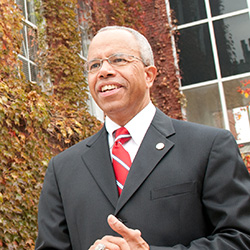Illinois State University’s standard measure graduation rate is at a record 70.4 percent and this year’s retention rate equals a historic high of 85 percent. During his annual State of the University address, President Al Bowman said Illinois State must do even more to attract and retain academically talented students. As a result, he is committing an additional $500,000 annually for merit-based scholarships, beginning next year.
“This is an important step that I know will make us even more competitive than we are today,” Bowman said. “At Illinois State, our students have demonstrated that it is an investment that yields high returns.”
Illinois State awards merit-based scholarships through the Presidential and University Scholars programs and provides assistance to hundreds of students through scholarships funded by gifts to the Illinois State Foundation. More than 20 percent of students receive need-based assistance through the state’s Monetary Awards Program (MAP). The University will use more than $7 million of its own resources to supplement MAP grants for students. More than $1 million in federal grant funding provides financial assistance for low-income and first-generation college students.
Illinois State, like all public universities, is faced with the challenge of operating during tough economic times. Illinois State began fiscal year 2011 with a state appropriation of about $80 million, around $5 million less than its fiscal year 2010 state budget. Bowman noted that it may be late this fall or even January before the University actually receives its state appropriation. Only 22.9 percent of Illinois State’s operational funding comes from the state.
“Still, there is positive news because Illinois State University is in a unique position financially,” said Bowman. “Our institutional debt is low. We have borrowed less than many institutions, so we owe less. Meanwhile, we are addressing our most critical maintenance needs, but putting off other big-ticket purchases that rely on state resources as long as possible.”
Bowman pointed to alternative revenue streams as a source of financial strength. During fiscal year 2010, Illinois State was awarded more than $21.3 million in grants and contracts, marking a $3 million increase over the previous year.
“We are also unique in terms of private fundraising,” Bowman said. “While many institutions have seen dramatic drops in private giving, the culture of philanthropy is growing stronger at Illinois State. For the fiscal year that ended June 30, the Illinois State University Foundation raised more than $13.25 million in gifts from alumni, friends and University stakeholders. Our endowment fund now stands at near $75 million, and last year we distributed more than $2.3 million to departments across campus. These funding streams have helped enhance scholarships, academic and support programs and facilities. They have allowed us to forego layoffs and furlough days.”
Illinois State’s reputation for excellence makes it a top-choice institution for academically talented students. The University continues to earn external validation from sources such as Kiplinger’s Personal Finance, which ranks Illinois State among the top 100 public universities for quality and value. However, Bowman stated that in a financial climate that forces colleges and universities to be more tuition dependent, it is important to keep enrollment numbers up without lowering admission requirements. Illinois State remains committed to an enrollment of between 20,000 – 21,000 students.
“That population ensures smaller class sizes, a lower faculty-to-student ratio and more academically talented students,” said Bowman. “It is critical that we do not allow enrollments to slip below that level. To maintain our current strong numbers of highly qualified students, Illinois State must maintain and even strengthen its position in student recruitment. We must prioritize scarce resources, creating more financial incentives for students to attend. We must also remain committed to the best in teaching and service.”
The core mission of Illinois State University is educating students and preparing them to be engaged and successful participants in a competitive multicultural society. Bowman noted that this fall’s freshman class of 3,190 students had an average ACT score above 24, while more than 400 new freshmen scored an ACT composite of 28 or above, and 141 scored 30 or above. Their high school grade point average was 3.38 on a 4.0 scale. The quantity and quality of students from underrepresented groups also remains strong with an enrollment of 2,724.
Looking ahead to the coming decades, Bowman thanked those involved in the University-wide effort to update the Campus Master Plan, which outlines future development at Illinois State. He also highlighted current and pending renovation and building projects, including the completion of life-safety improvements in Stevenson and Turner Halls, renovation of the Watterson Towers residence hall, expansion of instructional space for Mennonite College of Nursing, revitalization of Bone Student Center, the beginning of the University’s first ever public-private initiative for an 800-bed apartment-style student housing complex, and the approval of state capital funding for the Fine Arts Complex.
“As we continue to create a more attractive environment, we must continue our work to build and maintain a more sustainable environment,” Bowman said as he spoke of Illinois State’s ongoing commitment to a greener future. Sustainability is integrated into all aspects of campus operations including academics, grounds and facilities, purchasing, transportation, and energy and resource use. An official Office of Sustainability was formed this past July, with two fulltime staff members and two graduate assistants dedicated to furthering sustainability at Illinois State.
“In 2006, Illinois State was among the first universities to sign on to the Sustainable University Compact,” Bowman said. “In August, the Governor’s office unveiled a new version of the compact and on September 10, I signed the compact, once again making Illinois State one of the first signatories.”

